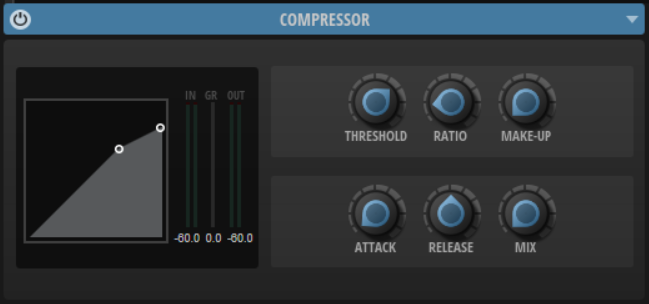Compressor
The Compressor reduces the dynamic range of a sound. This way, the sound gains headroom. You can use this extra headroom to make the overall sound louder again.

The input and output meters indicate the level before and after the compressor. The gain reduction meter in the middle indicates the current attenuation of the level. The peak level is shown below each meter. To reset the peak level, click the value field.
- Threshold
-
Sets the threshold. Sounds that are louder than the threshold are reduced in gain. Sounds below the threshold remain unchanged.
- Ratio
-
Sets the amount of gain reduction for sounds that are louder than the threshold. The higher the ratio, the more the output is lowered. For example, if the ratio is set to 2:1 and the amplitude of the sound is 4 dB above the threshold, the output is lowered by 2 dB. If the amplitude is 8 dB above the threshold, the output is lowered by 4 dB.
- Make-Up
-
Raises the overall level of the sound. This can become necessary if too much gain reduction is introduced by the Threshold and Ratio parameters. You can see the amount of gain reduction in the Gain Reduction (GR) meter.
- Attack
-
Determines how fast the effect reacts to sounds that exceed the threshold. The longer the Attack time, the longer it takes to reduce the gain. With longer Attack times, the onset of sounds exceeding the threshold passes through unprocessed.
- Release
-
Determines how fast the Compressor effect reacts to sounds that fall below the threshold. The longer the Release time, the longer it takes to return to the original level.
- Mix
-
Sets the ratio between the dry and the wet signal.
If Mix is set to 0%, only the wet effect signal is heard. If Mix is set to 100%, the output is composed in equal parts of the effect signal and the dry sound.